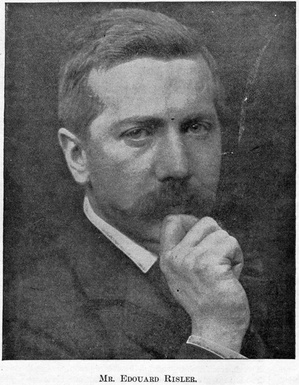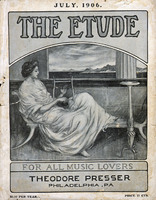BY ROBERT BRUSSEL
From the French by Edward Burlingame Hill
[Edouard Risler, one of the most evenly developed and highly gifted of the younger French pianists, was born of Alsatian descent at Baden-Baden, February 25th, 1873. He was for a long time the pupil of Louis Dièmer, perhaps the most celebrated teacher in Paris, at the conservatoire. He has also studied with Eugen d’Albert and Bernhard Stavenhagen. In this way his artistic personality possesses the salient qualities that characterize both French and German musical art. He shows the intensely serious conceptions of the masterpieces of piano literature, which are supposed to be preëminently Teutonic, in the finish and elasticity of his technique, in his sensitiveness to tonal gradations, and the grace and clear-cut quality of his phrasing he is as essentially Gallic and Parisian. His first appearances were with his teacher, Dièmer, in duets for two pianos. Among other works in repertory are Mozart’s concerto in C minor, Beethoven’s in G major, and E flat major, d’Indy’s “Symphony in a Mountain Air.” His interpretations of Beethoven are especially famous, and the series of Beethoven sonatas given earlier this season will shortly be repeated. Risler fares equally well at the hands of the public and the critics.—E. B. H.]
 Beethoven’s Piano Works Too Well and Too Little Known.
Beethoven’s Piano Works Too Well and Too Little Known.
Edouard Risler has recently finished in triumph a series of concerts in which he has played Beethoven’s thirty-two piano sonatas. The enterprise which he attempted was most dangerous. To interpret adequately the vast and many-sided thought, which Beethoven has sown so lavishly in these sonatas, upon an instrument of limited resources, was an ambition which few artists could hope to attain. Beethoven’s piano works are both too well and too little known. They are too well known because the hackneyed performance of some of them has been the cause of most unfortunate traditions; too little known because Beethoven’s ideas, in a deformed and caricatured presentation, are misunderstood, and because a large portion of the sonatas are virtually unknown. Beethoven, like almost all the masters, enjoys the singular privilege of being judged by those works which chance has made famous. It is not, as one might think, their worth which has made them conspicuous, but their facility of execution, their exterior qualities, their more or less superficial brilliance. From this it may be inferred that those works in which Beethoven expressed his thought most profoundly are the least known. It is certainly so in the case of the string quartets as well of the sonatas.
The Great Value of the Sonatas.
Surely the symphonies are considered the height of Beethoven’s sentiment. Here also we know a few well to the exclusion of the others. The sonatas are seldom admired as being the most intimate and the most moving record of the master’s emotion. Certainly some of them are well enough known, the “Pastoral,” the so-called “Moonlight,” the “Appassionata,” the Sonata with Variations (Op. 26), and some amateurs strain their erudition to the extent of playing Op. 106 and Op. 111 in order to be in fashion. But, deceived by the usual interpretation given them by pianists, who consider Beethoven as a mere opportunity for practice in a certain style, the public, in general, is not aware of the beauty which these sonatas manifest. Nevertheless, Beethoven put the best of himself into them. Freed from the orchestra (which, in spite of its comparative limitations, was a source of pleasure independent of the musical idea), it is in the sonatas that he expressed himself with the greatest freedom and depth. He broke with one tradition to create another; his thought broke the mould of conventional forms; in one direction he started the procession of progress, in another he stopped it.
A Picture of Beethoven Working Out the Conception of a Sonata.
It is easy to imagine Beethoven at the time when he was conceiving a sonata. He had been wandering through the country, perhaps among peasants occupied with the grim necessity of work. Sounds occurred near him, but he did not hear them; Nature chanted its eternal hymn of fertility; he was not aware of it. Then he returned to his home—somewhat like Faust in his study—where he had sought in vain the reasons of the force that impels us, the cause and end of our existence. Perhaps the sky is overcast, life weighs upon him insupportably. His soul hesitates—without doubt he would die gladly. But he has the innate vigor of autumn lands, which are desolate in ruin, the better to flower and bear fruit at the magic touch of Spring. In spite of all musical ideas fill his mind, his heart seems ready to burst like an over-ripe fruit with their force. Inspiration seizes him like a whirlwind. His hands run over the keyboard—the keyboard from which he cannot hear a sound, awakening a treasure of new rhythms. He is beside himself, he is intoxicated with his ideas. This agonized being—for to a musician deafness is surely an agony—grasps the life of an entire world, a world which fancy paints more truthfully than realism, a world of love and kindness. In his martyrdom joy is like a wound which drains inexhaustible sorrow; his melancholy is the melancholy of a generous and pitying heart, which spreads its influence like a twilight glow. This man, shut off from the realization of men’s joy, but also from their baser words, from the clamor of petty hatred and illusory vanities, deaf, poor, solitary, and even sometimes scoffed at, he creates his world, or rather re-creates it, according to his ideal, in which all the ecstatic liberty dreamed of during centuries by scholars, prophets, poets or other courageous souls, shines forth. Such is the humble and heroic story of the Beethoven sonatas, alike the story of all his works since that hour when Nature struck down this mortal, who seemed too great, too endowed with artistic capacity, in his most essential faculty.
Beethoven as a Pianist.
Beethoven’s sonatas demand an interpreter who is a musician as well as a pianist; in them form has given way to freedom of thought. The piano style even seems to have been written by a composer who was not a pianist, because of the real musical force of their themes. The first sonatas show this less, the influence of Haydn and Mozart makes the form more conventional.
It would have been interesting to be able to compare the performances by Risler, who seems to be the most perfect French interpreter of Beethoven, with those of Beethoven himself. Our information on this subject is rather vague, and in spite of the scholarly research of Mr. Th. Frimmel on Beethoven as a pianist, one can only permit vague hypotheses on this subject. However, it seems certain that this teacher, Christian Neefe, a pupil of Philipp Emanuel Bach, transmitted to him the soundest traditions. Beethoven’s contemporaries, Junker, Gelineck, Czerny and Cramer, are unanimous in declaring that his style was different from all pianists of his epoch, that he imparted a vivid character to that which he interpreted, that he played with prodigious force, and that he, obtained from instruments of feeble sonority, such as the Broadwood and Erard pianos of that time, which he possessed, overwhelming effects.
The Interpreter Demanded for the Sonatas.
The health, frankness, the robust serenity which emanates from his music, would seem the first qualities to be demanded in an interpreter of Beethoven. These rare and unusual qualities are precisely those most characteristic of Mr. Risler. He played the thirty-two sonatas with a grandeur and variety of sentiment truly admirable. He gave to the early sonatas grace and charm, to the later ones the expressive intensity which makes them so poignant. Thanks to him, the imperishable monument created by Beethoven, appeared to us as a whole, reflecting one of the most troubled lives that has ever existed. But nothing is artificial here, either in sentiment, thought or form. The grief is resigned, the gaiety is not strained. We do not find here the fugutive (sic) impressions of a weak and timid soul; there are cries of anguish or joy of a consciousness given up to utterance. Mr. Risler interpreted all this to us. I need not speak of his prodigious technic, of the enormous amount of work which this effort has cost him; that might appear to lessen it. He understood the ”new world” that Beethoven discovered, in his sonatas. As with the composer, the form is only the means to a noble end. It was the real thought of Beethoven which he gave us, with a simplicity and nobility more appealing than all the tricks of affectation.



